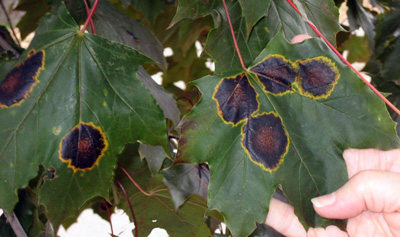Tar spot
July 31, 2015
Cause
 Fungus Rhytisma acerinum, causes large spots, up to nearly an inch in diameter; R. puntatum causes much smaller spots, about pinhead size.
Fungus Rhytisma acerinum, causes large spots, up to nearly an inch in diameter; R. puntatum causes much smaller spots, about pinhead size.
Hosts (both fungi)
Norway, silver, red, mountain, bigleaf and sugar maples; boxelder.
R. acerinum only
Norway, Amur and hedge maples.
Symptoms
As maple leaves develop to full size, light to yellowish green spots develop in the infected areas of the leaves. The area becomes yellow, with numerous small, raised, black spots forming within the yellow area. As late summer and early fall approaches, the black spots coalesce to form a large, irregular, shiny, raised spot with the appearance of wet tar, called a stroma. Severely infected leaves may fall prematurely.
How it’s spread
The disease cycle is similar for both species of the fungus that cause tar spot. In early spring, sticky spores are released from fruiting bodies on diseased maple leaves lying on the ground, and travel in the air to developing maple leaves. Within a month or two, light green spots develop on infected leaves. The tar-like spots don’t appear until late summer or fall. After overwintering, the tarlike lesions on fallen leaves produce sexual spores that infect young maple leaves and continue the cycle of infection for another season.
Management
In recent years, tar spot caused by R. acerinum has been increasing in frequency and severity in Michigan. The fungus overwinters on fallen, diseased maple leaves. Rake up and destroy maple leaves in autumn to reduce the amount of inoculum for the following spring. In the home landscape, raking up fallen leaves may be sufficient to manage the disease. In nursery settings, protective fungicide applications may be warranted as leaves develop in spring; consult your county Extension office for currently recommended products.
Print a PDF of this page: Tar spot



 Print
Print Email
Email


